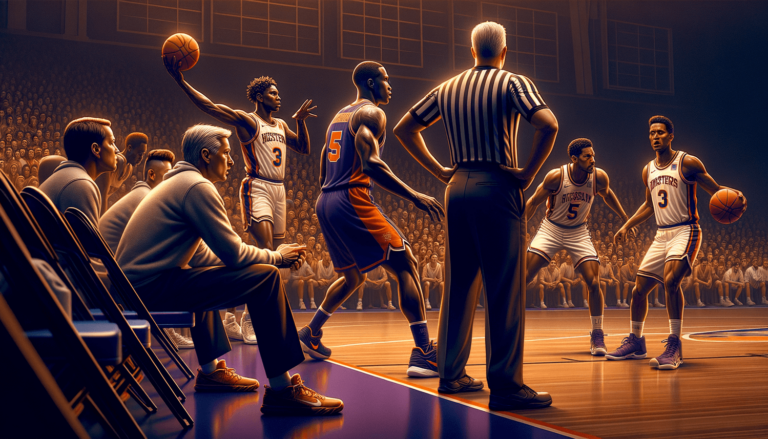
Five-Personal Foul Rule in College Basketball: Explained
Written by: Basketball Universe
Last updated:

Get ready to dive into the exciting world of college basketball as we explore the ins and outs of the Five-Personal Foul Rule! This ever-important yet often misunderstood aspect of the game plays a crucial role in strategizing each matchup. As you read on, you’ll gain a deep appreciation for how this rule helps maintain a fair and competitive atmosphere for the sport we all love. Don your referee stripes, dust off that whistle, and join us in this fun and professional journey to understand the Five-Personal Foul Rule in college basketball!
Five-Personal Foul Rule in College Basketball: Explained
The Five-Personal Foul Rule in college basketball refers to the maximum number of personal fouls a player can commit during a single game before being disqualified from further play. Personal fouls include actions such as holding, pushing, charging, or blocking against an opponent. When a player accumulates five personal fouls, they are forced to leave the game, and a substitute must take their place. This rule is in place to maintain fair play and discourage overly aggressive tactics that could lead to injuries or an unfair advantage.
Understanding Fouls in College Basketball
Before we delve into the specifics of the Five-Personal Foul Rule in college basketball, it’s essential to understand the different types of fouls that can be committed during a game. By knowing this, we can see how the five-foul rule aims to create a level playing field and maintain the integrity of the sport.
Personal Fouls
Personal fouls are the most common infractions in basketball and involve illegal physical contact between players, such as holding, pushing, tripping, or hitting. This type of foul typically results in the opposing team being awarded free throws or possession of the ball. Examples of personal fouls include:
- Blocking: A defender obstructs the path of an offensive player by moving into their way without having established position.
- Charging: An offensive player runs into a stationary defender who has already established position.
- Hand-checking: A defender places their hand on an offensive player to impede their movement.
- Illegal screen: A player sets a screen that is not stationary, causing illegal contact with the defender.
Technical Fouls
Technical fouls are non-physical infractions committed by players or coaches, such as disrespectful behavior towards game officials or unsportsmanlike conduct. This type of foul typically results in a single free throw for the opposing team. Examples of technical fouls include:
- Disrespectful language or gestures towards game officials or opponents.
- Delay of game: A player or coach intentionally slows down the game by violating time restrictions or making unnecessary requests.
- Illegal substitution: A player enters the game without following proper substitution procedures.
- Dress code violations: A player fails to wear the proper uniform, accessories, or equipment during the game.
Flagrant Fouls
Flagrant fouls are severe, intentional fouls committed by a player that could potentially lead to injury. These generally result in ejection from the game and suspension or fines for the offending player. Examples of flagrant fouls include:
- Striking or attempting to strike an opponent with extreme force.
- Intentionally grabbing or holding onto an opponent’s body to prevent them from falling after being airborne.
- Intentionally tripping an opponent who is in the air or attempting a shot, causing them to lose balance and fall.
History and Rationale Behind the Five-Personal Foul Rule
Now that we have an understanding of the different types of fouls, let’s take a look at the history of the Five-Personal Foul Rule in college basketball. The rule has its roots in the early era of basketball, when the sport was still developing, and teams were trying to create a balance between physicality and skill.
During the early days, basketball rules were more lenient towards fouling. However, as the sport grew in popularity and competition increased, stakeholders realized the need for more stringent foul regulations. The Five-Personal Foul Rule emerged as a way to maintain that balance while promoting fair play and player safety.
The Evolution of the Foul Limit
Initially, the number of fouls committed by a player before they were disqualified varied across different leagues and levels of play. Over time, however, the five-foul limit became the standard in college basketball, proving to be an effective deterrent to prevent overly aggressive play that could potentially lead to injury.
In professional leagues like the NBA, the foul limit has been slightly higher – set at six personal fouls to account for the longer games and higher level of play. However, the five-foul rule remains the standard in college basketball, striking a balance between fostering competitiveness and maintaining the integrity of the game.
Implications of the Five-Personal Foul Rule in College Basketball
The existence of the five-foul rule has various strategic and tactical implications for the teams, coaches, and players involved in college basketball games. Below, we’ll discuss some of the immediate effects and strategies around this rule:
Foul Trouble
When a player accumulates multiple fouls early in the game, they are said to be in “foul trouble.” When a key player faces this situation, coaches must make difficult decisions, such as resting the player until later in the game or substituting them altogether. This can have a significant impact on gameplay and team dynamics, especially if the player in question is a star performer.
Foul Strategy
Coaches often develop game plans to exploit the Five-Personal Foul Rule, focusing on drawing fouls on opposing players, primarily those they consider crucial to the opposing team’s success. This might involve running plays that force a specific opponent into difficult defensive situations or bait them into committing fouls. As a result, coaches must constantly re-evaluate their strategies throughout the game to adjust for foul trouble among players.
Impact on Game Tempo
Another implication of the Five-Personal Foul Rule is its effect on the tempo of the game. When a team has several players in foul trouble, the game can become less fluid as both teams focus on avoiding further foul calls. This can lead to more conservative play as teams try to avoid committing additional fouls, which ultimately slows down the game and potentially affects the outcome.
Referee Discretion
Though basketball rules provide guidelines on what constitutes a personal foul, the decision ultimately lies with the game official. Referee discretion is a significant factor in how the Five-Personal Foul Rule impacts a game. As interpretations can differ, teams and players must adjust to the officiating style of each game, ensuring they do not repeatedly violate rules that can lead to foul trouble.
Navigating The Five-Personal Foul Rule: Tips And Tricks For Players And Coaches
Now that we understand the significance and implications of the Five-Personal Foul Rule in college basketball, let’s explore some tips and tricks to help players and coaches navigate this critical aspect of the game:
Know Your Opponent
Scouting and understanding the opposing team’s playing style can provide helpful insights into how they accumulate fouls or draw fouls from their opponents. Use this knowledge to tweak your game plan and remain mindful of potential foul trouble situations, adjusting your strategy accordingly to gain a competitive edge.
Play Smart Defense
Defensive tactics play a significant part in managing fouls. By adopting sound defensive techniques and maintaining good body position, players can reduce the occurrence of defensive fouls while still effectively defending against their opponents. Practicing proper defensive footwork and positioning helps minimize your chances of becoming a victim of a crafty offensive player drawing fouls.
Effective Communication
Team communication, both on and off the court, is critical in managing foul trouble situations. Coaches should ensure that their players are aware of the foul counts and any foul trouble situations that may arise during the game. In-game communication from teammates, such as alerting players to potentially dangerous defensive positions, can help them avoid committing unnecessary fouls.
Strategic Substitution
A crucial weapon in a coach’s arsenal is the ability to strategically substitute players based on foul counts. By rotating players throughout the game to manage and distribute fouls, coaches can prevent key players from getting into foul trouble and maintain a competitive edge. Talented bench players can often prove instrumental in managing this aspect of the game, as they can step in when necessary to help alleviate foul trouble among starters.
In conclusion, the Five-Personal Foul Rule in college basketball shapes the sport in various ways: from game strategy to player development. Understanding the intricacies of this rule and its implications on the game can help players, coaches, and fans appreciate the complexity and beauty of basketball. By learning about basketball rules like the Five-Personal Foul Rule, you will enhance your understanding and enjoyment of the game we all love!
Managing Personal Foul Consequences
Understanding the potential consequences of reaching the five-personal foul limit is crucial for both players and coaches. The ability to alleviate the impact of fouls on gameplay can significantly influence the outcome of a game. Here, we will explore some of the strategies and considerations for effectively managing the consequences of personal fouls.
Free Throw Importance
The majority of personal fouls result in free throws for the opposing team, so practicing and perfecting free throw shooting is an essential skill for all basketball players. A team that consistently capitalizes on their free throw opportunities can exploit their opponents’ foul trouble, securing essential points and increasing their chances of victory.
Defensive Adjustments
When key players accumulate fouls, it becomes necessary for coaches to make defensive adjustments to protect those players from disqualification. Coaches may switch from man-to-man defense to zone defense, allowing players in foul trouble to avoid one-on-one situations that could lead to additional fouls. Zone defenses can also help distribute foul responsibility across the entire team, minimizing the likelihood of any single player reaching the five-foul limit.
Understanding Opposing Players’ Tendencies
Studying opposing players’ tendencies and habits can help teams identify which players are more prone to committing fouls or drawing fouls from their opponents. Coaches can develop their game plan accordingly, targeting specific players to provoke fouls or protect their players from being drawn into foul trouble.
Balancing Aggression
Striking the right balance between aggression and avoiding fouls is vital for any basketball player. Players must learn to play aggressively without committing unnecessary fouls, increasing their team’s competitiveness without sacrificing stability through foul trouble. This balance can be developed through practice, experience, and situational awareness during games.
Comparing College and Professional Basketball Foul Rules
While college basketball employs the Five-Personal Foul Rule, professional basketball, such as the NBA, uses a slightly different approach to fouls. It’s interesting to explore the differences and rationale behind each rule to understand the impact these regulations have on the game at various levels.
Six-Personal Foul Rule in the NBA
The NBA operates under a six-personal foul rule, allowing players one more foul before disqualification compared to college basketball. This rule accounts for the longer games played at the professional level, with matches featuring four 12-minute quarters instead of the 20-minute halves used in college basketball. The extra allowable foul provides a cushion for players while maintaining a similar foul-to-playing time ratio as in college games.
Defensive Three-Seconds Violation
In the NBA, a defensive three-seconds violation may be called if a defender remains in the restricted area (the area near the basket) for more than three seconds without actively defending an opponent. This rule attempts to limit zone defenses and promote a faster, more exciting style of play. The penalty for defensive three-second violations is a technical foul, with the opposing team being awarded one free throw. In college basketball, there is no defensive three-second rule, allowing teams more flexibility in their defensive strategies.
Understanding the differences in foul regulations between college and professional basketball helps to highlight the unique characteristics and challenges of each level. Fans, coaches, and players can appreciate the nuances of the sport, whether they are watching or participating in a collegiate or professional game.
FAQ: Five-Personal Foul Rule and Related Concepts
In this section, we’ll answer some frequently asked questions related to the Five-Personal Foul Rule in college basketball and its implications on gameplay, strategy, and players. These questions provide additional insights into the inner workings of foul regulations and their effects on the sport.
1. Why is there a different personal foul limit for college and NBA players?
The difference in personal foul limits between college basketball (five fouls) and the NBA (six fouls) is primarily due to the different game lengths. College games are shorter, with two 20-minute halves, while NBA games are longer, featuring four 12-minute quarters. The extra personal foul allowed in the NBA provides a cushion for players in a longer game, maintaining a similar foul-to-playing time ratio as in college games.
2. What happens when a college basketball player reaches the five-foul limit?
When a college basketball player accumulates five personal fouls, they are disqualified from the game. The player must leave the court, and a substitute replaces them. This rule is in place to maintain fair play and prevent overly aggressive tactics that could lead to injuries or an unfair advantage.
3. Can a player re-enter a game after reaching the five-foul limit?
No, once a player reaches the five-foul limit, they are disqualified from the game and cannot re-enter. A substitute must replace them for the remainder of the game.
4. What is the penalty for a technical foul in college basketball?
A technical foul in college basketball typically results in the opposing team being awarded two free throws and possession of the ball. This penalty applies to both player and coach technical fouls.
5. How does a flagrant foul differ from a personal foul?
A flagrant foul is a severe, intentional foul committed by a player that could potentially lead to injury. These fouls typically result in ejection from the game and can also lead to suspension or fines for the offending player. Personal fouls, on the other hand, are the more common illegal physical contacts that occur between players on the court.
6. Are all personal fouls counted towards the five-foul limit?
Yes, all personal fouls are counted towards the five-foul limit in college basketball. However, technical fouls and flagrant fouls have separate consequences and are not counted towards the personal foul limit.
7. How can players avoid getting into foul trouble?
Players can avoid getting into foul trouble by playing smart defense, maintaining good body position, and practicing proper defensive footwork. Additionally, understanding the officiating style of the referees in each game can help players adjust their play to avoid accumulating fouls.
8. Can a coach be ejected from a game due to technical fouls?
Yes, a coach can be ejected from a game if they receive two technical fouls. Just like players, coaches must adhere to the rules and display good sportsmanship to avoid penalties that can impact their team.
9. How do teams typically adapt when a key player is in foul trouble?
When a key player is in foul trouble, coaches may adopt different strategies, such as resting the player until later in the game, making defensive adjustments, or using strategic substitutions to spread fouls among the team. The coach’s ability to adapt the game plan and communicate effectively with players is essential in managing foul trouble situations.
10. Are there any tactics to draw fouls on opposing players?
Yes, teams can employ tactics to draw fouls on opposing players. This may involve running plays that force specific opponents into difficult defensive situations, where they are more likely to commit fouls. Understanding opposing players’ tendencies and tailoring a game plan to exploit their weaknesses can be an effective strategy to provoke fouls.
Featured Posts
- No pillar pages found.





